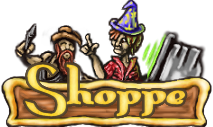niltrias wrote:You could have some differences based on cultures, as opposed to race. For example, you could have the Slavs, the Finns, and the Nords, which from their culteral background have predispositions towards things like combat, building, and survival or farming.
Different cultures could also offer different starting gear, maybe. Some could start with linen shirts, some start with cowhide tunics, etc. Or even just hats...hunter-culture types start with hats that give a slight bonus to combat, farming culture types start with straw hats...That would make the player base a bit more varied, especially among newbies, without getting into a racial controversy or adding elements that dont fit the games feel.
much better, though the names should be changed to reflect that these are hearthlings and not human
just stay the fuck away from the usual fantasy bullshit
George Ziets wrote:"I've heard rumors that you are tired of "medieval fantasy" RPGs. I'm pretty sure that I know what you mean, but I'm curious about your reasons. Also, what exactly did you do to separate Mask of the Betrayer from such games?"
I think this depends on whether I’m thinking as a player or as a designer.
First, the player’s perspective. When I open a new book, or sit down to watch a movie, or purchase an RPG, I want to be introduced to a world that I’ve never imagined before. I’m drawn to fantasy and science fiction for the thrill of discovery - to peel away the layers of setting and learn the “rules” of a new world. Some writers are brilliant at this. George R. R. Martin and Scott Lynch are two of my more recent favorites.
Now, it certainly isn’t impossible for an imaginative and intriguing world to be set in medieval Europe (or some facsimile thereof). The two authors I just mentioned base a lot of their material on real-world European cultures, and I found that The Witcher also presented a fresh take on some old formulas. But many, many games (and less effective novels) seem to be mired in the same old formula. As soon as I see elves, dwarves, and orcs, I can pretty well guess how they relate to one another, and what the world is going to be like… and I’m usually right (The Witcher notwithstanding). Once my curiosity has faded, so has my interest in the book, movie, or game.
That brings me to the designer’s perspective… and now that I think about it, the two perspectives are pretty closely related. As a designer, I need to be inspired by my game’s setting. Even when I’m the author or lead writer, I’ve got to have that sense of discovery. That’s what gets me out of bed for a long day of building levels, designing quests, or writing dialogue. It’s all a process of discovery. If I’m drawing my inspiration from, say, Slavic mythology - not something I knew much about, before I worked on MotB - then I’m truly learning and discovering something new. And that leads to all sorts of new ideas and connections. But if I’m working in the same old fantasy setting that I’ve been reading and playing for twenty years… it’s awfully difficult to come up with fresh and exciting ideas.
I think that was my first realization on MotB. To craft a story that I’d feel excited about, I needed to move the player into a new and previously unseen part of the Forgotten Realms. The Sword Coast felt like a pretty generic setting - one I’d seen many times before. Rashemen, on the other hand, was an interesting pastiche of Slavic and Japanese elements, with animistic undertones. Once I’d immersed myself in Slavic, Japanese, and animistic mythologies, the basic ingredients of MotB really began to take shape. I’d never have been able to craft the story of Mask if I’d “stayed” in the Sword Coast. Creativity requires fresh ammunition.


